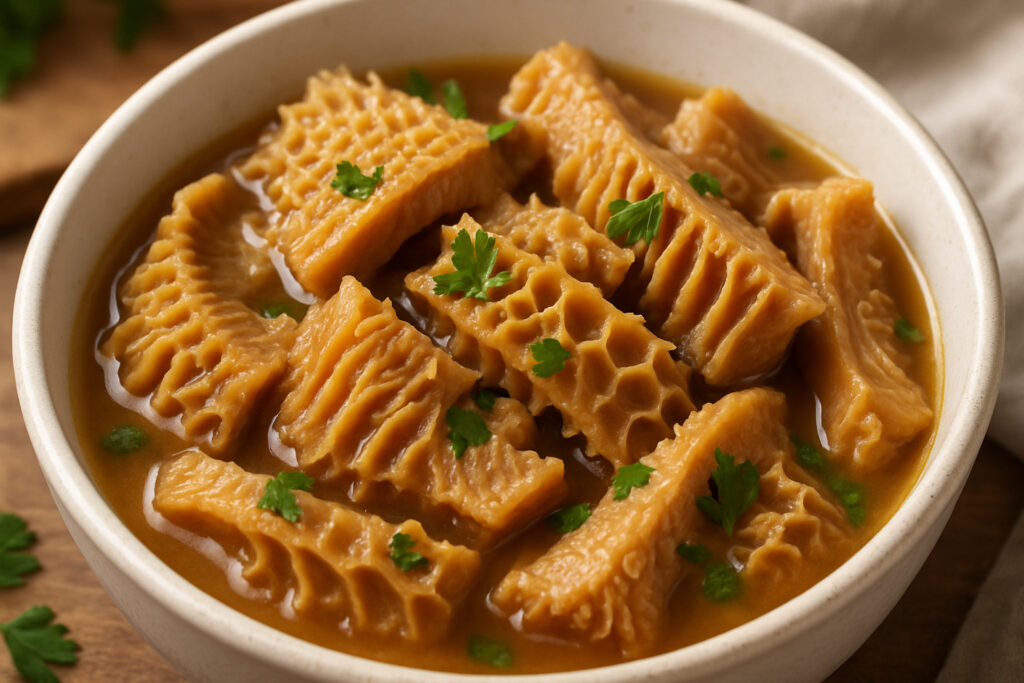What Is Tripe and Why Food Triprs Should Care
Tripe is the edible stomach lining of ruminant animals like cows, sheep, and goats, and it’s one of the most polarizing ingredients in global cuisine. While many Americans find it intimidating, this versatile protein has been feeding families worldwide for centuries and plays a starring role in beloved dishes from Mexican menudo to Italian trippa alla romana.
Quick Facts About Tripe:
- What it is: Cleaned stomach lining from four-chambered animals
- Main types: Blanket (smooth), honeycomb (textured), book (layered), reed (glandular)
- Taste: Mild flavor that absorbs surrounding seasonings and spices
- Texture: Chewy to tender depending on cooking method and time
- Nutrition: High protein (12g per 100g), rich in vitamin B12, low fat but high cholesterol
For the adventurous foodie traveler, tripe represents everything exciting about authentic culinary exploration. It’s the kind of ingredient that separates tourist traps from genuine local experiences. You’ll find it simmering in family-run taquerias in Mexico City, braised with tomatoes in Roman trattorias, and steaming in dim sum baskets across Hong Kong.
Beyond its culinary merit, tripe embodies the sustainable eating philosophy that modern food lovers increasingly value. Using every part of the animal reduces waste, supports regenerative farming practices, and connects us to food traditions that prioritized resourcefulness over squeamishness.
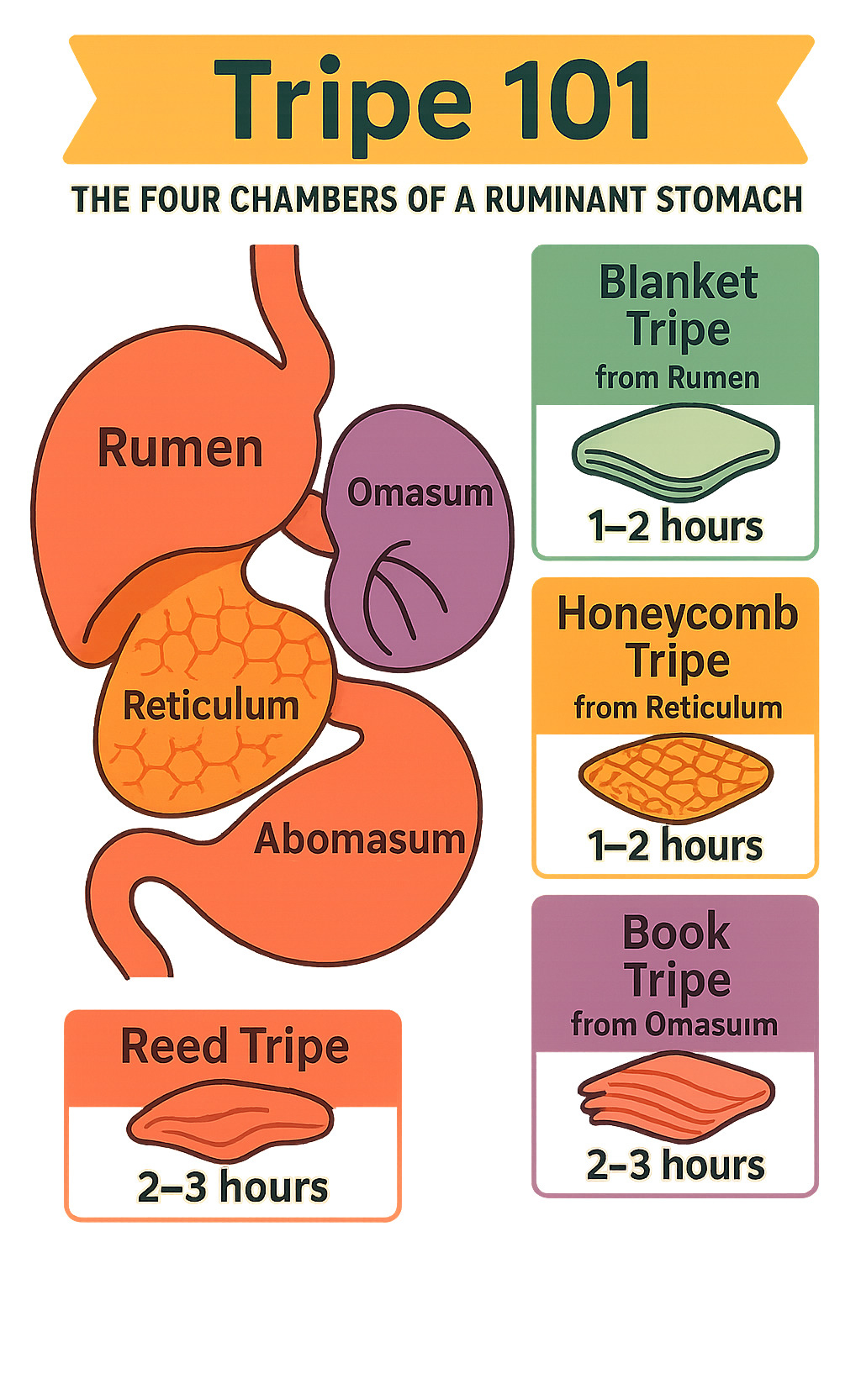
What Is Tripe? Origins, Anatomy & Key Varieties
Understanding tripe means exploring ruminant animals and their remarkable four-chambered digestive systems. Cows, sheep, goats, and other grazing creatures have evolved something truly amazing – a stomach that works like nature’s own food processing plant, turning simple grass into high-quality protein.
The rumen (first chamber) starts breaking down plant matter, while the reticulum (second chamber) acts like a filter. The omasum (third chamber) absorbs water and nutrients, and the abomasum (fourth chamber) works like human stomachs, using acid to finish digestion.
When we talk about tripe, we’re referring to the cleaned, prepared lining from these stomach chambers. Each chamber produces tripe with different textures, appearances, and cooking needs.
| Tripe Type | Source Chamber | Texture | Cooking Time | Best Uses |
|---|---|---|---|---|
| Blanket | Rumen | Smooth, robust | 2¼ hours | Long braises, hearty stews |
| Honeycomb | Reticulum | Diamond-patterned, tender | 1½ hours | Delicate preparations, flavor absorption |
| Book/Bible | Omasum | Layered, folded | 1¼ hours | Regional specialties |
| Reed | Abomasum | Glandular, rare | Variable | Specialty uses, casings |
Types of Tripe You’ll Find at the Butcher
Blanket tripe comes from the rumen and appears smooth and flat. This is the most robust and chewy variety, perfect for long, slow braises. Plan on about 2¼ hours of cooking time.
Honeycomb tripe is the real superstar, coming from the reticulum with gorgeous diamond-shaped patterns. Those natural pockets act like flavor reservoirs that soak up spices and seasonings. It’s the most tender variety and what you’ll typically see in grocery stores.
Book tripe has a unique appearance – it literally looks like folded pages from the omasum chamber. Those layers create multiple surfaces with distinctive texture, cooking in about 1¼ hours.
Reed tripe from the abomasum is rarely seen in regular cooking – it’s more of a specialty item used for traditional preparations or sausage casings.
Green Tripe Explained
Green tripe isn’t actually green – it’s brownish and completely unprocessed, straight from the animal. While it has a very strong odor, it’s like a superfood for pets, packed with natural enzymes and probiotics.
For human consumption, virtually all tripe you’ll buy has been “dressed” – thoroughly cleaned, trimmed, and often bleached to get that white appearance. This processing removes intense odors and makes tripe much more kitchen-friendly.
Nutrition & Health Profile of Tripe
Nutritionally, tripe delivers impressive value. A 100-gram serving contains just 85 calories while packing 12 grams of high-quality protein and only 3.7 grams of fat.
Tripe excels in vitamin B12 content – 58% of your daily needs in a single serving. The mineral profile includes iron, zinc, phosphorus, and selenium. It’s also loaded with natural collagen, which breaks down during cooking to create rich, gelatinous broths.
Is Tripe Healthy or Not?
Tripe is genuinely nutritious, offering complete protein with essential amino acids plus valuable vitamins and minerals for relatively few calories. The low fat content appeals to those watching fat intake.
The main concern is cholesterol – a 3-ounce cooked serving contains 133mg, substantial enough that tripe doesn’t qualify as “lean meat” under FDA guidelines. For most people eating a varied diet, this isn’t problematic when consumed in moderation.
Environmental & Ethical Considerations
Choosing tripe supports nose-to-tail eating, using every part of the animal instead of wasting nutrition. Tripe from grass-fed animals offers additional environmental benefits, as properly managed grazing systems help fight climate change by sequestering carbon in soil.
Grass-fed ruminants contribute to ecosystem health while producing more nutrient-dense organs and meat. Tripe typically costs significantly less than premium cuts, making sustainable eating more accessible while supporting ethical farming practices.
Global Cuisines & Classic Dishes Featuring Tripe
When you travel with an appetite for authentic experiences, tripe becomes your passport to beloved comfort foods worldwide. This humble ingredient has inspired legendary dishes that define entire culinary traditions.
Mexican menudo reigns as perhaps North America’s most famous tripe dish. This vibrant red soup combines tender honeycomb tripe with hominy corn, dried chilies, and warming spices in a broth that takes hours to perfect. Weekend mornings across Mexico see families gathering around steaming bowls, often claiming it can cure hangovers.
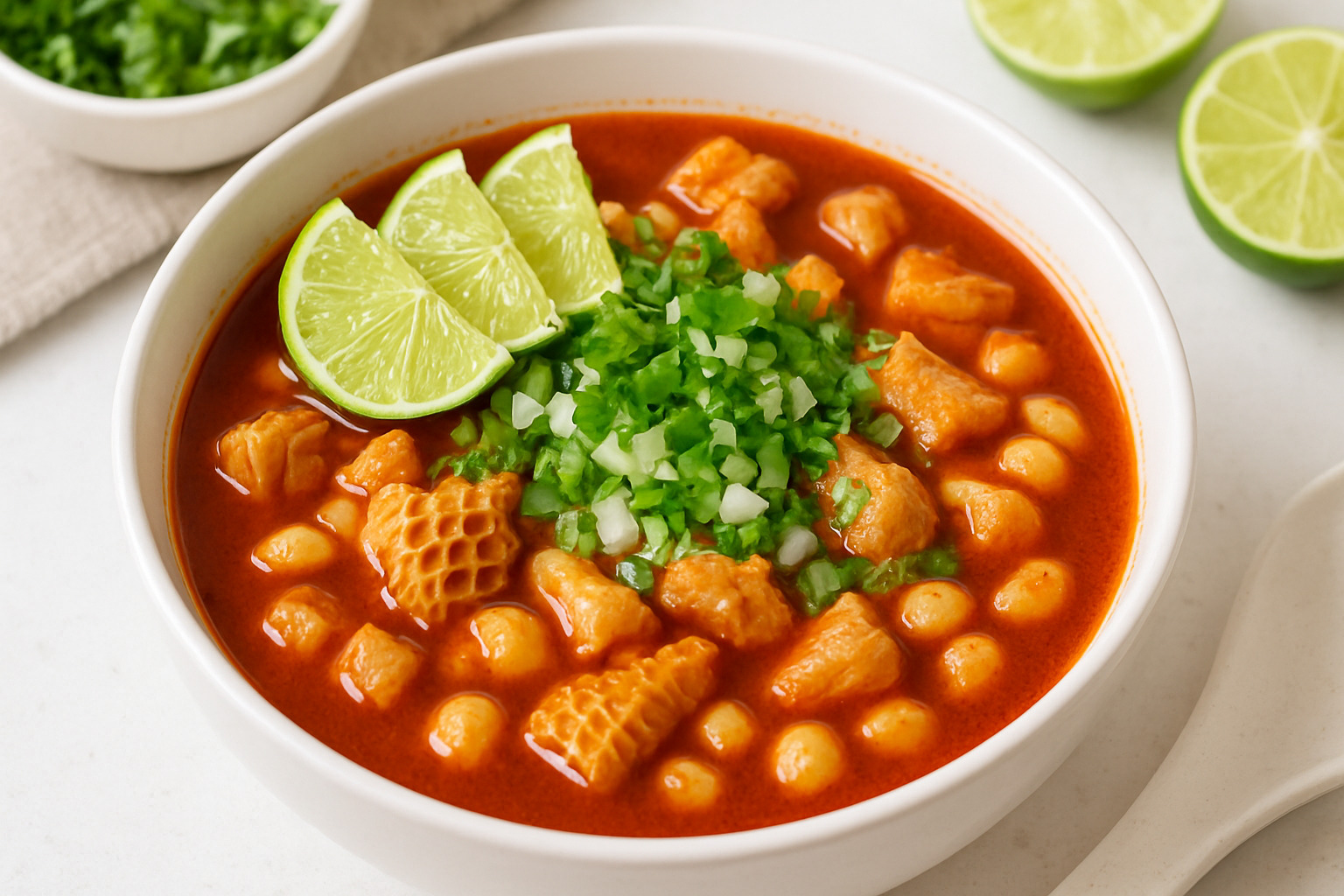
Italy’s trippa alla romana showcases how Roman cooks liftd tripe to fine dining status. This dish braises honeycomb tripe in rich tomato sauce brightened with fresh mint and finished with sharp pecorino cheese.
Spain’s callos a la madrileña brings tripe to the tapas table, combining tender tripe with spicy chorizo, blood sausage, and smoky pimentón paprika. French tripes à la mode de Caen represents ultimate slow-food cooking, taking up to ten hours to prepare properly with all four tripe types, calf’s foot, and local cider.
Taste & Texture: What to Expect
The biggest surprise for first-time tripe eaters is how mild it actually tastes. Tripe acts as a “flavor sponge” that absorbs whatever seasonings surround it, making it incredibly versatile.
Texture matters more than flavor. When cooked properly, it should have perfect “al dente” quality – tender enough to chew comfortably but with satisfying structure. Undercooked tripe feels like rubber bands, while overcooked tripe turns mushy.
Must-Try Tripe Dishes Around the World
Vietnamese pho bo features paper-thin tripe slices in aromatic beef broth. Portuguese tripas à moda do Porto earned Porto residents the nickname “Tripeiros” and combines tripe with white beans and chorizo. Philadelphia pepper pot carries historical significance, allegedly helping sustain Washington’s troops at Valley Forge.
Peruvian cau cau brings vibrant yellow color from turmeric and aji amarillo peppers. Chinese dim sum restaurants serve tripe braised with ginger and scallions, while Brazilian dobrada appears at celebrations, combining tripe with beans and vegetables.
For more inspiration on global food trips, explore our guide to Middle Eastern Food: A Flavorful Journey Through Tradition and Culture.
Buying, Cleaning & Cooking Tripe at Home
Finding tripe requires venturing into ethnic markets where it’s treated like the culinary gem it is. Mexican carnicerías, Asian markets, and European delis regularly stock tripe, unlike typical grocery stores.
You’ll encounter “dressed” tripe – already cleaned, trimmed, and bleached to characteristic white color. Look for tripe that appears creamy white and feels firm. It should have minimal odor and costs a fraction of premium cuts.
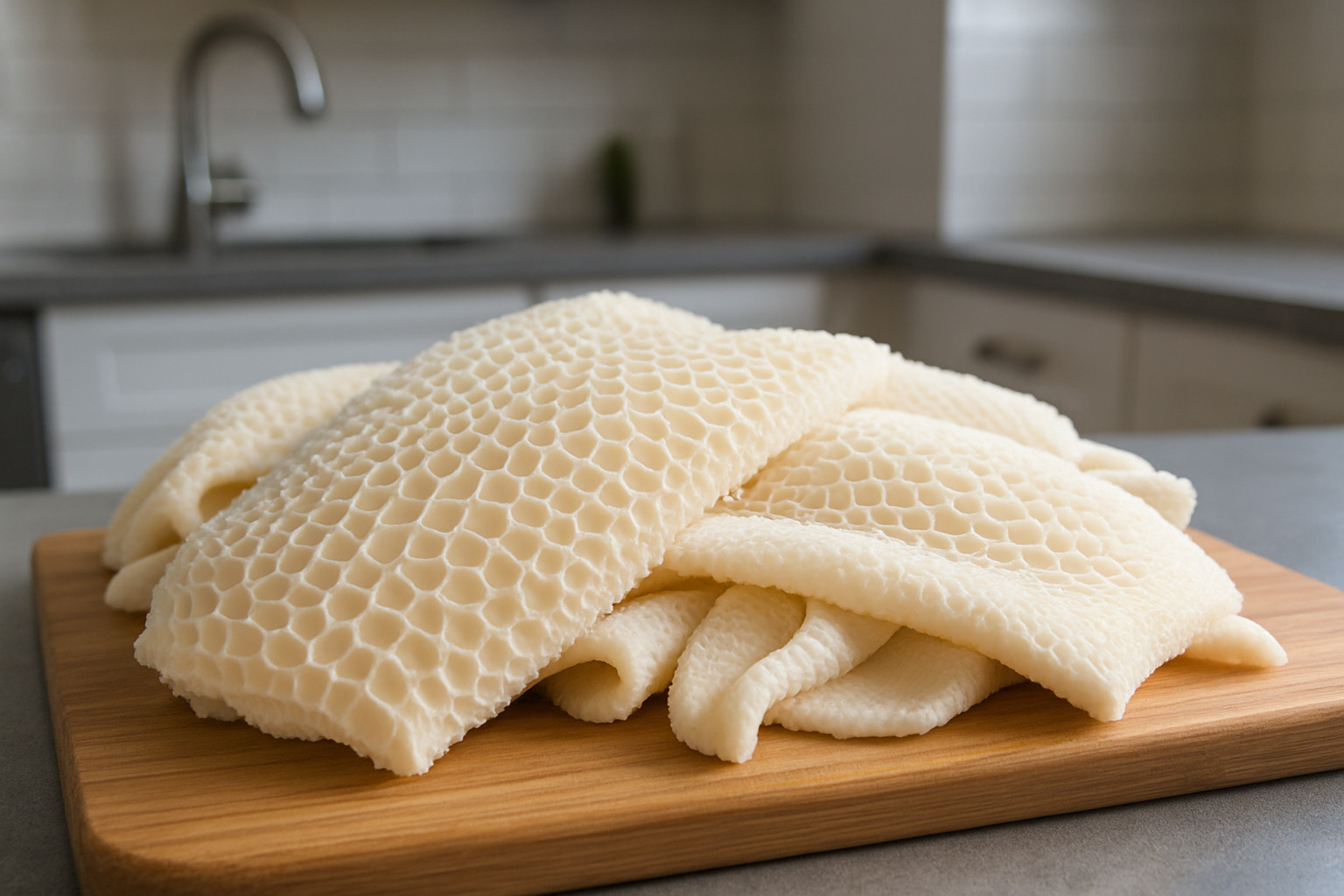
Step-by-Step Cleaning & Preparation Guide
Even pre-cleaned tripe benefits from extra attention at home. Start with thorough rinsing under cold water, then trim any fat or membrane with a sharp knife. Cut into 2-3 inch squares for even cooking.
Soak in acidulated water (water mixed with vinegar or lemon juice) for 30 minutes to neutralize odors and tenderize tissue. Sprinkle coarse salt over pieces and gently scrub, then rinse until water runs clear.
Finish with a quick pre-boil: simmer tripe in salted water with aromatic vegetables for 15 minutes to remove remaining odors.
Foolproof Cooking Techniques & Pro Tips
The golden rule for tripe: patience wins every time. This isn’t quick-fix cooking – it’s slow-food that rewards time investment.
Slow braising works beautifully for beginners. Brown aromatic vegetables, add prepared tripe with enough liquid to cover, then simmer gently for 2-4 hours. You’ll know it’s ready when a knife slides through easily.
Pressure cookers can save time – cook under high pressure for 45-60 minutes after browning. Tripe often tastes better the day after cooking as flavors meld overnight.
Key professional tips: never skip pre-boiling, add acidic ingredients like tomatoes or wine to help break down fibers, and don’t be shy with bold seasonings. For technical insights, scientific research on cooked tripe quality provides detailed information.
History, Culture & Changing Perceptions of Tripe
Tripe tells a remarkable story of social change and evolving food culture. For centuries, this stomach lining served as nutritional lifeline for working families, but it wasn’t just “poor people’s food” – it was appreciated across social classes.
Samuel Pepys proves this point in his famous diary entry from October 24, 1662, writing about enjoying tripes. Today we celebrate that date as World Tripe Day, honoring both Pepys and long culinary tradition.
Tripe reached commercial peak in mid-20th century England through United Cattle Products (UCP) restaurant chain, operating over 150 specialized tripe restaurants across northwestern England during the 1950s.
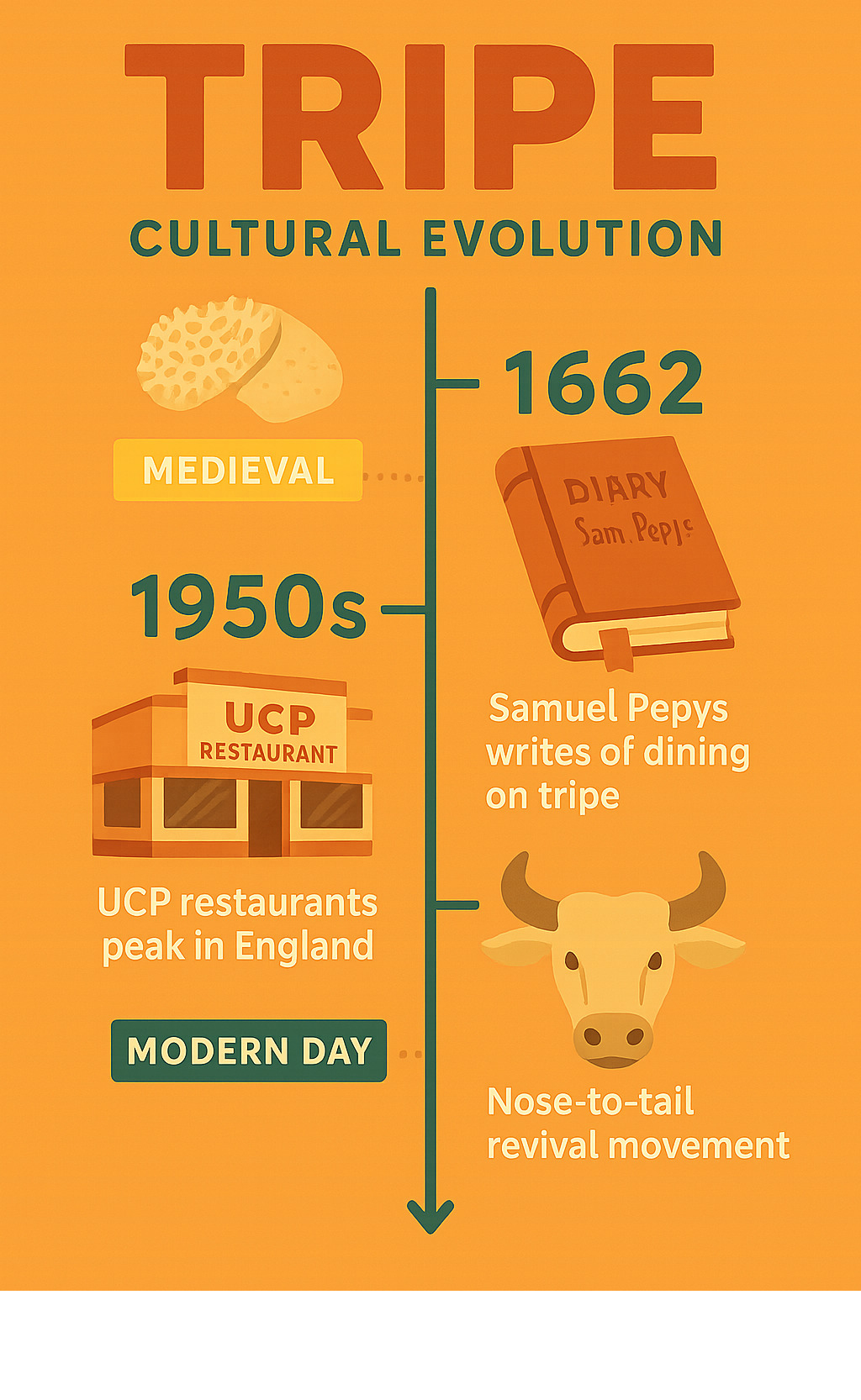
Decline came with post-war prosperity as families abandoned traditional foods for prestigious proteins. Today’s food lovers are refinding tripe through nose-to-tail cooking, sustainability concerns, and authentic culinary experiences.
Common Misconceptions & Challenges
Tripe faces serious image problems, mostly from assumptions rather than experience. The “it smells terrible” myth comes from days when home cooks cleaned fresh tripe themselves. Today’s commercially prepared tripe arrives ready to cook with minimal odor.
Safety worries are largely unfounded – properly prepared tripe goes through thorough cleaning and inspection. Long cooking times (2-4 hours at high temperatures) eliminate concerns.
Texture aversion usually stems from poor preparation. Properly cooked tripe should be pleasantly tender and satisfying. Complaints about unpleasant texture typically involve undercooked or overcooked preparations.
For adventurous eaters, overcoming preconceptions opens doors to authentic cultural experiences unavailable in mainstream restaurants. Our World Cuisine Exploration guide offers insights into approaching unfamiliar foods with curiosity.
Frequently Asked Questions about Tripe
What animals does tripe come from?
Tripe comes exclusively from ruminant animals – those remarkable creatures with four-chambered stomachs that can turn grass into protein. This specialized digestive system is what makes their stomach lining so unique and nutritionally valuable.
Beef tripe dominates most markets and restaurants worldwide. It comes from cattle and offers the most consistent texture and flavor profile. This is what you’ll typically find in Mexican markets for menudo or at Italian grocers for trippa preparations.
Sheep tripe brings a more delicate flavor and slightly different texture. It’s particularly prized in Mediterranean and Middle Eastern cuisines, where lamb plays a central role in traditional cooking. The smaller size means quicker cooking times and a more tender final result.
Goat tripe appears frequently in Caribbean jerk preparations, West African stews, and certain Asian dishes. It has a slightly stronger flavor than beef tripe but remains mild enough to absorb surrounding spices beautifully.
You might occasionally encounter deer tripe in game cooking or traditional hunter preparations, though this remains quite specialized.
Here’s something that confuses many home cooks: pork stomach is sometimes called “tripe” in certain regional dishes, but it’s technically different since pigs aren’t ruminants. However, it’s prepared using similar techniques and appears in dishes like Pennsylvania Dutch souse.
How long should I cook tripe for ideal tenderness?
The cooking time for tripe depends entirely on which type you’re working with and your desired final texture. Think of it like pasta – there’s a perfect “al dente” point where it’s tender but still has pleasant chew.
Honeycomb tripe needs about 1.5 to 2.5 hours of gentle simmering. This is the variety most home cooks encounter, and it’s forgiving enough that slight overcooking won’t ruin the dish. The natural pockets in honeycomb tripe help it absorb flavors while maintaining good texture.
Blanket tripe requires the longest commitment – typically 2 to 3 hours of patient cooking. This smooth, flat variety is the toughest of all tripe types, but when properly cooked, it offers a satisfying, substantial bite that works beautifully in hearty stews.
Book tripe cooks much faster, usually reaching perfect tenderness in just 1 to 1.5 hours. Its layered structure breaks down more quickly, so watch it carefully to avoid overcooking.
If you’re using a pressure cooker, you can achieve excellent results in 45 to 60 minutes under high pressure. This method works particularly well for weeknight cooking when you want tripe but don’t have hours to spare.
The real secret is testing for doneness rather than watching the clock. Properly cooked tripe should yield easily to a sharp knife but still offer some resistance. Undercooked tripe feels like chewing rubber bands, while overcooked tripe turns unpleasantly mushy and loses all its appealing texture.
Does tripe really help cure hangovers?
This question comes up wherever tripe soups are traditional morning-after remedies. From Mexican menudo to Greek patsás to various Eastern European preparations, cultures worldwide swear by tripe’s hangover-fighting powers.
The honest answer? There’s no scientific evidence that tripe itself has special hangover-curing properties. However, these traditional dishes do provide several elements that genuinely help your body recover from a night of overindulgence.
The rich broth provides crucial hydration to counter alcohol’s dehydrating effects. Your body desperately needs fluids after drinking, and warm, flavorful broth goes down much easier than plain water when you’re feeling queasy.
These soups deliver important electrolytes like sodium and potassium that help restore your body’s mineral balance. Alcohol disrupts these levels, contributing to that awful hangover feeling.
Tripe itself contributes high levels of B vitamins, especially B12, which support your liver’s metabolism processes. Your liver works overtime processing alcohol, and these nutrients help fuel that recovery work.
The combination of protein and fats in tripe dishes helps stabilize blood sugar levels, which often drop dramatically after drinking. This stabilization can reduce hangover symptoms like shakiness and irritability.
Perhaps most importantly, there’s the comfort factor. When you’re suffering, a warm bowl of familiar, traditional food provides psychological relief that shouldn’t be underestimated. The ritual of preparing or sharing hangover food with others creates a sense of care and recovery.
So while tripe might not be a magical hangover cure, these hearty soups certainly provide exactly what your body needs: hydration, nutrition, and comfort. Sometimes the best medicine combines good nutrition with cultural wisdom and a little bit of love.
Conclusion
Your journey into tripe is just beginning. What started as curiosity has hopefully transformed into appreciation for one of the world’s most sustainable and culturally rich proteins.
Tripe embodies everything rewarding about food exploration. It connects us to communities that have perfected recipes over generations, from weekend menudo traditions in Mexican families to ancient Roman techniques in modern trattorias. When you order tripe at authentic restaurants, you’re participating in living food history.
The sustainability aspect makes this culinary trip even more meaningful. By choosing tripe, you support nose-to-tail eating that reduces waste and honors the whole animal, often supporting smaller, family-owned establishments maintaining traditional food ways.
Tripe teaches us that life’s most satisfying experiences require courage. That first spoonful of perfectly seasoned menudo often marks when adventurous eating becomes genuine passion. The change from “I could never eat that” to “I can’t wait to try the Portuguese version” happens faster than expected.
For food lovers ready to expand culinary horizons, tripe offers accessible entry into authentic cultural dining. Whether exploring vibrant food scenes or planning international culinary trips, seeking traditional tripe preparations leads to genuine, family-run establishments.
Ready to find more unique ingredients and authentic food experiences? Our comprehensive Best Food Destinations guide helps you plan culinary trips that go beyond typical tourist restaurants, connecting you with foods and traditions that define each culture.
Every food lover was once intimidated by something that later became a favorite. Tripe simply asks for the same open mind that makes all great culinary findies possible – and the rewards are absolutely worth it.

